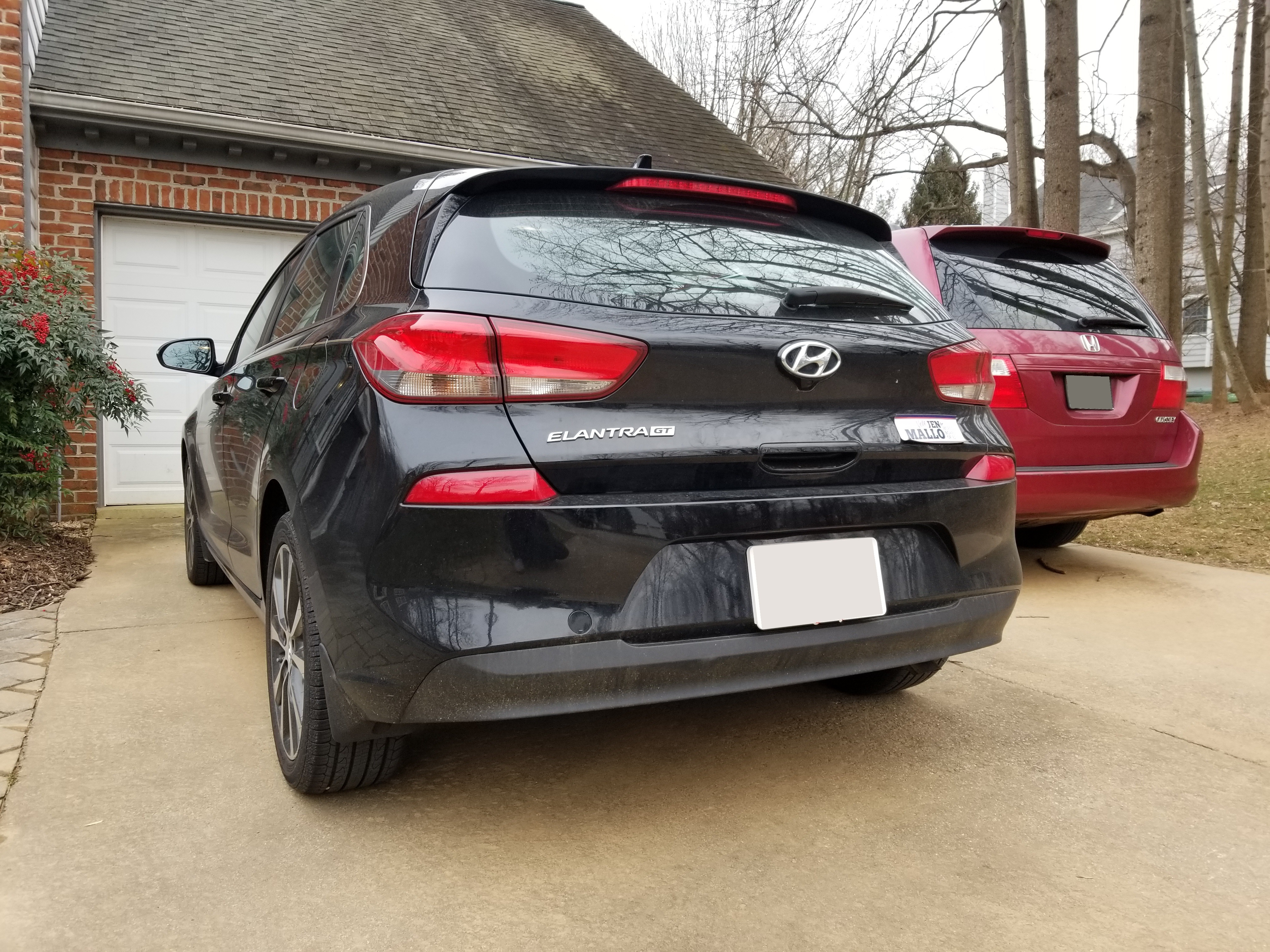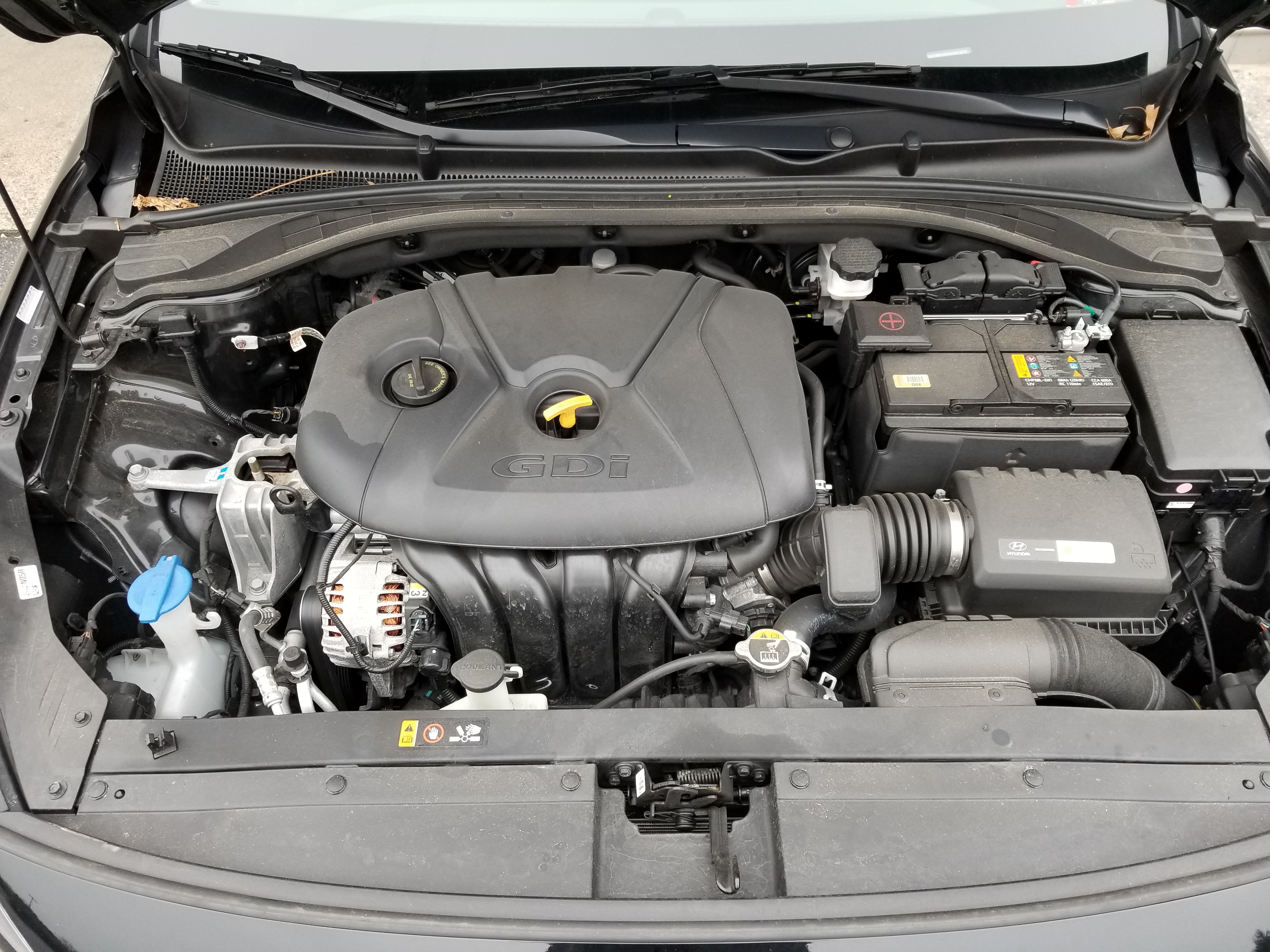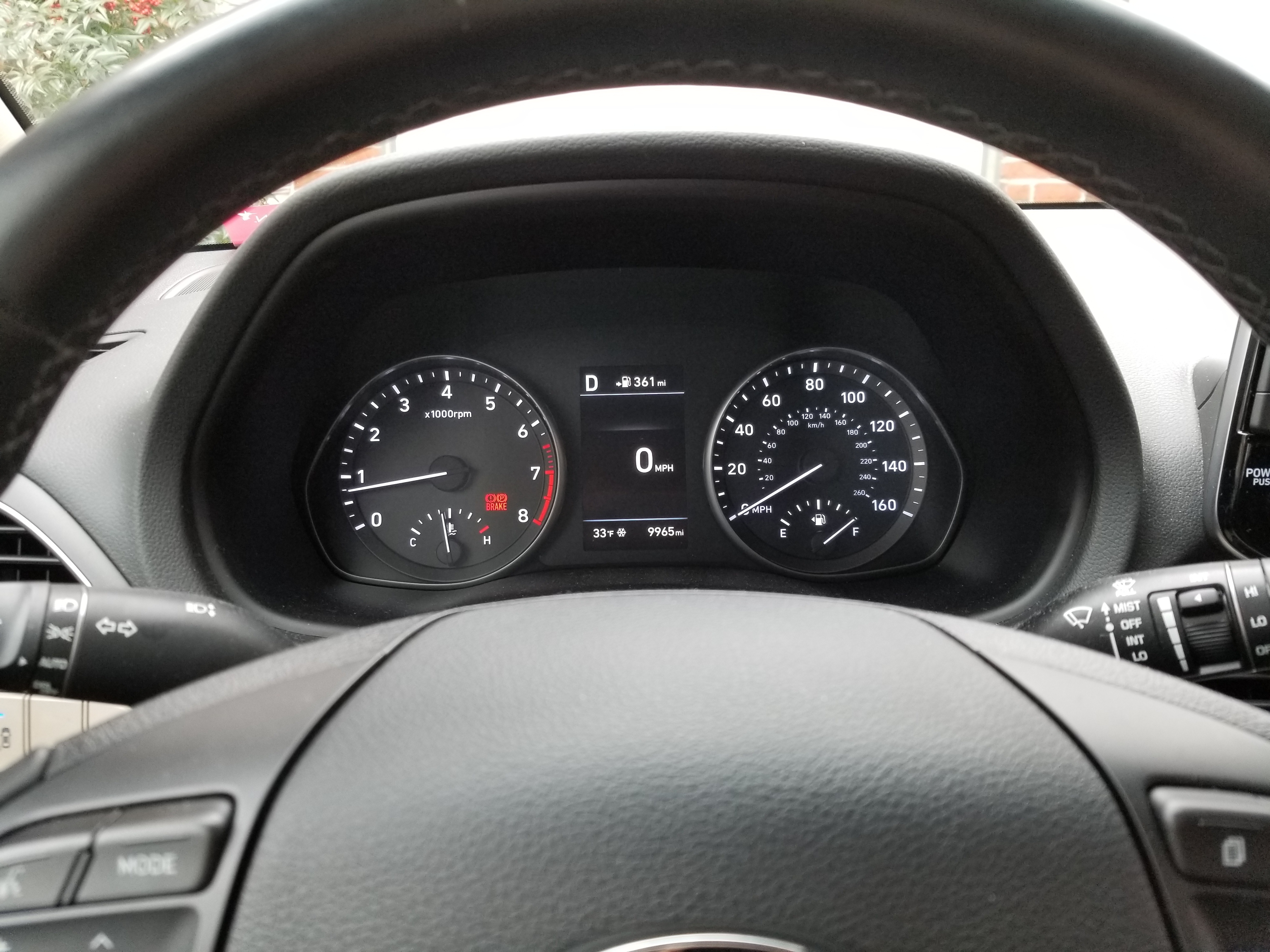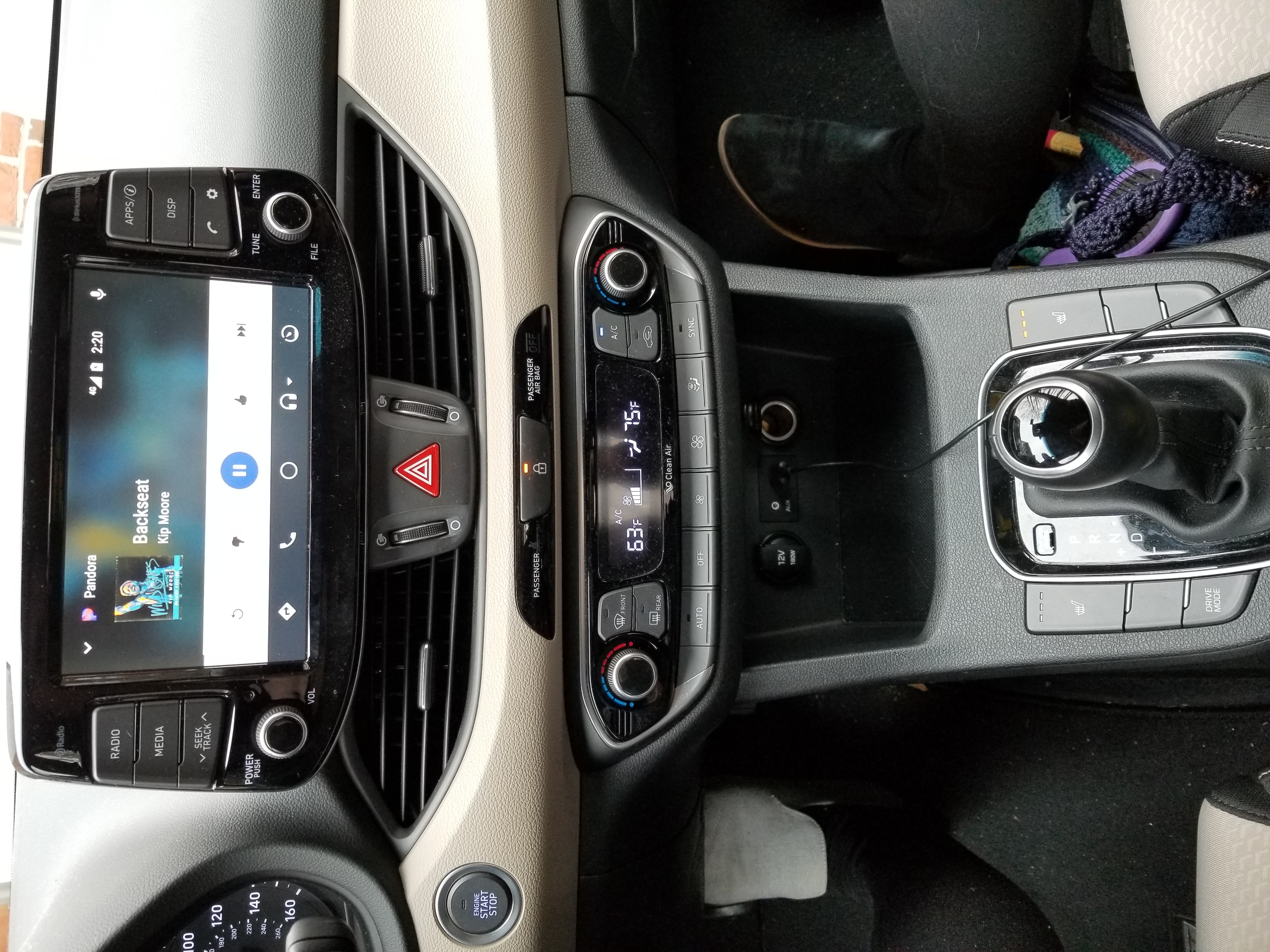Here's another Elantra. I won't get tired of them.

What is it?
The Elantra GT rides the sometimes fuzzy edge between sporty cars and sports car. For about $20,000, you get a (sort of) powerful engine, (sort of) sporty handling, and (sort of) good fuel economy, and a solid suite of driver assistance and comfort features as well. In a day and age where compact crossovers are getting more and more popular (and we all know you don't buy one if you care about saving gas), these make the Elantra GT quite relevant and competitive in the modern compact family car segment. But what did Hyundai want the Elantra GT to be? They could have compromised performance for better efficiency, but they didn't. The car doesn't even have an eco driving mode. In the era of cheap gas and high expectations, though, this might not be such a bad thing.
Externally the Elantra GT looks entirely sensible, following Hyundai's trend of not rocking the boat visually. The Kona might well be the first offbeat-looking car they've made! Though it doesn't exactly stand out, the Elantra GT is still pleasing to the eye, however. Its lines taper towards the nose, emphasizing the new, sharper headlights (compared to the 2017 Elantra) and large grille that features a mostly-open feax mesh grille. Fortunately, its obligatory fake front bumper cheek vents and lower-bumper secondary grille are unobtrusive, bucking the negative space-obsessed trend of front bumper styling. The thick D-pillars let the back windows taper nicely, making it look more sleek and less boxy, and a rear window spoiler keeps the lines of the rear end interesting.

Where the Elantra GT betrays its economy car nature is the interior; no premium materials or innovative UX systems are to be found here. That said, most materials have a satisfying enough look and texture, and most importantly, all buttons and controls feel solid and mature, though practically every fixture has just a little bit of flex and wobble to it. Consider what you're getting though; a punchy engine, a lot of electronics, and plenty of space for 20 large; at this price point, premium interior fittings aren't exactly to be expected. To its credit though, with the optional improved interior package, the Elantra GT offers some satisfying contemporary features like independent climate control, heated seats, blind spot warning, and a big, freestanding touchscreen, that features the standard suite of smartphone infotainment features and solid menu design. With pushbutton ignition, the Elantra GT feels like a budget executive car, and looks and drives respectably enough to fit the bill.
How does it drive?
Better than the sedan, that's for sure.
The Elantra GT features a 2.0L I4 engine that, unlike the sedan, does not use the Atkinson cycle, allowing it to develop about 160hp and 150 lb-ft of torque. The power seems to come on at lower engine speed than some other four cylinders I've driven, and when in Sport mode, responds enthusiastically and provides great control over speed and acceleration. When crusing, the engine keeps a calm growl, feeling powerful while not being intrusively loud. At higher engine speeds, such as during manual driving or when driving in sport mode, however, a buzzy note appears, making increasing vibration and engine noise; shifting manually might get annoying for your passengers quick. The engine's 150 hp is more than enough to launch the Elantra GT enthusiastically, and will gladly redline itself when in Sport mode, and gives the hatchback a performance feel that might escape it with a more efficient engine like the sedan's 2.0L Atkinson motor. The Elantra GT's vim and vigour comes at a cost though: even a new 2019 Elantra GT will only make about 27 mpg combined (according to Hyundai's website, real figures may differ), which feels a little old fashioned when economy economy cars these days will happily make 30-32mpg combined if driven carefully. My automatic transmission 2006 Civic makes better combined mileage than the Elantra GT. For a base-model car, I would rather Hyundai have given the GT a smaller, more efficient engine with quicker electronic throttle response. Power isn't everything, and sacrificing 10-15 hp for mileage that's actually competitive with modern cars seems like a fair trade to me. That said, if you absolutely need a midsize five-door hatchback and you're too cool for a Golf GTI/R, the Elantra GT Sport (now called the GT N Line) features a 1.6L turbocharged I4 that pushes out 200hp. The Elantra GT is not a heavy car, and 200hp would make it more than punchy, and might well verge into "startling" territory. I'll have to drive one to find out. The N Line also features either a six-speed manual or a seven-speed dual clutch gearbox, with the DCT hopefully (I haven't driven a Hyundai DCT that wasn't coupled to a hybrid drivetrain, and as such, I can't comment on their quality) performing better than the Elantra GT's six-speed automatic transmission.

The Elantra GT's automatic gearbox is a perfectly good transmission for most driving conditions, and won't let down the casual driver. In its normal driving mode, it upshifts quick, keeps engine vibration down, and is willing, if reluctant, to kick down for hard acceleration. Acceleration is good enough in normal mode, but the throttle response feels soft and weirdly nonlinear; modulating speed takes some practice to figure out, and modulating acceration is actually rather difficult. At shallow pedal deflections, the throttle is rather unresponsive, and ramps up quickly when you put your foot down. While good for laid back driving, the normal driving mode doesn't feel responsive enough to be intuitive for me. However, Sport mode quickens throttle response (electronically, of course) and makes the transmission bias for lower gears, and makes a huge difference for driving performance. The car feels much more lively in Sport mode, and is quite fun to fool around with. The steering does not become appreciably more sensitive in Sport mode, but this is mitigated by the fact that the normal steering is already sensitive enough. This, along with the amount of engine power, makes the Elantra GT feel more sporty than the Elantra sedan, befitting of the GT nameplate.


Like the Elantra sedan, manual shifts are quick and the shifter feels good in the hand, and dynamic driving through corners and curves feels good with it either shifting for itself or on command. One weird note is that in Sport mode, the car is reluctant to shift up to 6th gear, even when cruising on a highway, and sometimes needs to be commanded to do so. Of course, changing to normal mode also fixes this. Like the Elantra sedan, normal and Sport modes are toggled with a single button. While this makes the shifter simpler, it makes changing into Sport mode a little hard to do without good muscle memory; I prefer when Sport mode is accessible through the shifter itself, as Hyundai's approach seems to imply that you pick what you want while stopped, and don't change anything once you're moving. In general, the Elantra GT's powertrain makes for quick, if not astonishing, acceleration, comfortable cruising, and great potential for fun when driven manually or while in Sport mode. With the GT hatchback, Hyundai seems to admit to themselves that the Elantra is a fun car to drive, even in its least exciting version, the base model sedan.
Like the Elantra sedan, the GT rides on McPherson struts up front and a torsion beam in the back, with the N Line version upgrading to a fully independent rear suspension. For most drivers, that won't be necessary, as the torsion beam is more than good enough for most purposes. I find it likely that understeer will be worse with the torsion beam due to the sympathetic roll/camber coupling that such a design develops, but body roll is well controlled and the car feels planted and responsive in most scenarios. I felt confident tossing the Elantra GT through corners, and the wide tires and big wheels (225/45R17) keep grip during cornering without much complaint. I am a little miffed that the normal Elantra forgoes the multilink rears, however; if it's all the same floorpan, why not make the base model nicer to drive? As always, the reason is cost, but Honda Civics have been cost-competitive for years while coming with standard fully independent suspension. The suspension does a good job of isolating major bumps and shocks while keeping road feel, but the rear end feels a little isolated and numb, and I think would benefit from stiffer rear springs.

Like the Elantra sedan, the GT's interior, from a UX standpoint, is quite well designed. Wipers and lights are placed where you expect, and while the complicated HVAC console is intimidating at first, it becomes second-nature soon enough. Heated seats, blind spot warning, push button ignition, and independent climate control all add a touch of class to the otherwise normal economy car electronics. The rocker switches on the steering wheel have been made a little more streamlined from the 2017 model, which can be good or bad, depending on how you tend to use that type of switch, but the steering wheel controls themselves are logical enough for a modern car. The gauge cluster is carried over from the 2017 model and is rich in information without being too cluttered, and its multifunction display plays well with the main infotainment system. The seats are well-padded and have deep shoulder bolsters, and support the driver effectively for hard cornering.
The infotainment, for better or for worse, is on a freestanding screen that extends up from the dashboard. I personally dislike this, but it does allow the display to be closer to the driver's sightlines while still letting the dashboard fascia sit lower and appear a bit more streamlined. The car, like all modern vehicles, has a backup camera, and with the thick D pillars, the blind spots are big, and the blind spot warning lights and backup camera give the driver more confidence. Cruising on the highway is comfortable, but road noise is louder than it maybe could be. This doesn't bother me personally, but I know some people do dislike it. If visibility is a priority for you, get the sedan. While there isn't anything particularly special about Hyundai's UI design for the Elantra, it's still intuitive to use, doesn't have many frustrating foibles, and has a decent range of functionality. The Elantra family would actually make very good rental cars, come to think of it.


What does it mean?
Overall, the Elantra GT seems to push itself as a budget executive car. It offers a wide range of creature comforts, a good deal of power with an engine that promises excitement, and contemporary styling that fits right in with the status quo, if not exactly pushing the envelope. This is a car that is carefully designed to satisfy its driver; anybody who makes good money won't notice its less-than-competitive gas mileage, and it doesn't look so flashy that people start to ask weird questions about you or your ride. The Elantra GT is designed to be a car that makes you feel like you've made it. You finally land a real job, one that has a salary instead of paying you hourly, and you're on top of the world, and you need a better ride than mom's old Bonneville. With 160hp, a fancy infotainment system, and dual zone climate control, the Elantra GT feels like a real professional's car, and the automatic headlights and the fact that you don't need to turn a key to start it makes it feel like you just got a Cadillac for half the price. Your Elantra GT is sensible, sporty (it's not like the average use case involves every single horsepower that engine can deliver), loaded with features, and above all, pretty darn comfortable for a car of its size. The Elantra GT is a car that makes you feel like you've made it, and it only costs $20-23K. It's hard to not feel like you just got the steal of the century.
So the Elantra GT, from the outside, may feel like a run-of-the mill hatchback, or some kind of half-baked hot hatch that can't measure up to the promises its name makes. That doesn't actually matter, ultimately. This car's biggest effect is the way it makes you feel. Sure, it doesn't turn heads, and isn't a world-beater in the quarter mile, but you get the feeling of prestige and value at a great price, and the feeling that you've got something special on your hands is hard to come by. If you like to drive, the Elantra GT will probably satisfy you. If you don't like to drive, it'll probably satisfy you. If this is your first car, it'll still probably satisfy you. The Elantra GT plays into what Americans have come to expect as marks of quality for cars, and that's exactly what Hyundai wanted.
I note now a parallel with the emotional message of the Elantra GT and the V6 Dodge Charger. The Elantra GT is one of the cheapest cars you can get that really makes you feel like you've made it; the V6 Charger is one of the cheapest cars you can get that makes everybody else think you've made it. We love hood bulges, deep exhaust notes, and a big Super Track Pak button, and the aesthetic of force and power, but we also love the plucky underdog, and sitting next to a Charger in your Elantra GT kinda makes you feel like one.